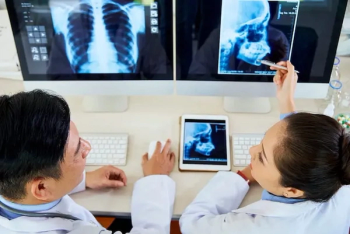
Uncommon CT colonography perforations still cause concern
Perforation rates for a CT colonography, while still low and acceptable, are fast approaching those of traditional optical colonoscopy.
78-year-old man with perforation of the sigmoid colon at CT colonography. A scout film obtained after insufflation of air prior to CT colonography demonstrates a rectal tube within the rectum (thin white arrow) and air around bowel loops (black arrows). An inguinal hernia on the left contains the sigmoid (thick white arrow) (Provided by J. Sosna)Perforation rates for a CT colonography, while still low and acceptable, are fast approaching those of traditional optical colonoscopy. As virtual colonoscopy battles to gain broader acceptance, researchers are considering other parameters with which to compare the two modalities. Alongside performance and concerns about technique, they are looking at patient safety issues, including perforation rates."One of the major deterrents to widespread implementation of CT colonography has been the fear of perforation," lead author Dr. Jacob Sosna, a physician at Hadassah Hebrew University Hospital in Jerusalem, said during a Sunday scientific session.In a retrospective review of a 45-month period between January 2001 and April 2004, Sosna and colleagues examined three medical centers' records for data about perforation and subsequent management and outcomes for these patients.Of 9120 CT colonography exams, there were six (five male, one female) perforations, yielding a 0.066% perforation rate, Sosna said. Roughly one in 1520 cases resulted in a perforation. Perforation risk increased with age, the study found. Four patients required surgical intervention, and no exams resulted in deaths during the period.Older males with underlying colonic pathologies were at a higher risk for perforations, Sosna said.CT colonography techniques are constantly evolving, and the development of narrower catheters and better insufflation techniques will continue to decrease the risk of complications.During a panel discussion at the end of the session, moderator Dr. C. Daniel Johnson, a professor of radiology at the Mayo Clinic, Rochester, expressed concern that CT colonography perforation rates are more in line with optical colonoscopy rates rather than the one in 10,000 rates seen with barium enema. One of the possibilities is that use of barium contrast may not require as much air at insufflation as CT colonography, and physicians can actually see what they're doing, said panel participant Dr. Martina Morrin, an assistant professor of radiology at Harvard Medical School.With CT colonography, it may not be clear that there is a problem until the patient reports pain, she said. Additionally, the perforation rate should be placed in the perspective of the 59,000 deaths attributed to colorectal cancer every year.For more information from the online Diagnostic Imaging archives:
Newsletter
Stay at the forefront of radiology with the Diagnostic Imaging newsletter, delivering the latest news, clinical insights, and imaging advancements for today’s radiologists.




